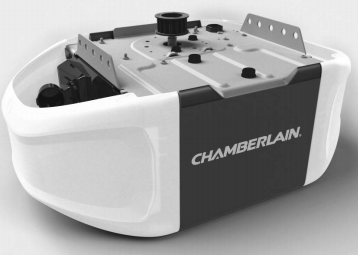FOR RESIDENTIAL USE ONLY
PRE-PROGRAMMED REMOTE CONTROL INCLUDED
• Please read this manual and the enclosed safety materials carefully! • Fasten the manual near the garage door after installation.
• The door WILL NOT CLOSE unless the Protector System® is connected and properly aligned.
• Periodic checks of the garage door opener are required to ensure safe operation.
• Please read this manual and the enclosed safety materials carefully! • Fasten the manual near the garage door after installation.
• The door WILL NOT CLOSE unless the Protector System® is connected and properly aligned.
• Periodic checks of the garage door opener are required to ensure safe operation.
• The model number label is located on the left side panel of your garage door opener.
• This garage door opener is compatible with MyQ® and Security+ 2.0® accessories.
• DO NOT install on a one-piece door if using devices or features providing unattended close. Unattended devices and features are to be used ONLY with
Preparation
Safety Symbol and Signal Word Review
This garage door opener has been designed and tested to offer safe service provided it is installed, operated, maintained and tested in strict accordance with the instructions and warnings contained in this manual.
When you see these Safety Symbols and Signal Words on the following pages, they will alert you to the possibility of serious injury or death if you do not comply with the warnings that accompany them. The hazard may come from something mechanical or from electric shock. Read the warnings carefully.

When you see this Signal Word on the following pages, it will alert you to the possibility of damage to your garage door and/or the garage door opener if you do not comply with the cautionary statements that accompany it. Read them carefully.

WARNING: This product can expose you to chemicals including lead, which are known to the State of California to cause cancer or birth defects or other reproductive harm. For more information go to www.P65Warnings.ca.gov
Unattended Operation
The Timer-to-Close (TTC) feature, the MyQ® Smartphone Control app, and MyQ® Garage Door and Gate Monitor are examples of unattended close and are to be used ONLY with sectional doors. Any device or feature that allows the door to close without being in the line of sight of the door is considered unattended close. The Timer-to-Close (TTC) feature, the MyQ® Smartphone Control, and any other MyQ® devices are to be used ONLY with sectional doors.
Check the Door

– ALWAYS call a trained door systems technician if garage door binds, sticks, or is out of balance. An unbalanced garage door may NOT reverse when required.
– NEVER try to loosen, move or adjust garage door, door springs, cables, pulleys, brackets or their hardware, ALL of which are under EXTREME tension.
– Disable ALL locks and remove ALL ropes connected to garage door BEFORE installation and operating garage door opener to avoid entanglement.
– DO NOT install on a one-piece door if using devices or features providing unattended close. Unattended devices and features are to be used ONLY with sectional doors.

– ALWAYS disable locks BEFORE installing and operating the opener.
– ONLY operate garage door opener at 120V, 60 Hz to avoid malfunction and damage.
Before you begin:
- Disable locks and remove any ropes connected to the garage door.
- Lift the door halfway up. Release the door. If balanced, it should stay in place, supported entirely by its springs.
- Raise and lower the door to check for binding or sticking. If your door binds, sticks, or is out of balance, call a trained door systems technician.
- Check the seal on the bottom of the door. Any gap between the floor and the bottom of the door must not exceed 1/4 inch (6 mm). Otherwise, the safety
reversal system may not work properly. - The opener should be installed above the center of the door. If there is a torsion spring or center bearing plate in the way of the header bracket, it may be
installed within 4 feet (1.2 m) to the left or right of the door center.

Before You Connect with Your Smartphone
Monitor and control your garage door from anywhere using the MyQ® app. You will need a router with Wi-Fi and a smartphone or other mobile device. Make sure your mobile device is connected to your Wi-Fi network. Hold your mobile device in the place where your garage door opener will be installed and check the Wi-Fi signal strength.

Check Signal Strength. If you see:
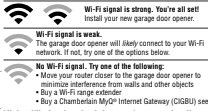
Visit wifihelp.chamberlain.com for more details
Additional Items You May Need
Survey your garage area to see if you will need any of the following items:
- (2) 2X4 Pieces of wood : May be used to fasten the header bracket to the structural supports. Also used to position the garage door opener during installation and for testing the safety reversing sensors.
- Support bracket and fastening hardware: Must be used if you have a finished ceiling in your garage.
- Extension brackets (MODEL 041A5281-1) or wood blocks: Depending upon garage construction, extension brackets or wood blocks may be needed to install the safety reversing sensor.
- Fastening hardware: Alternate floor mounting of the safety reversing sensor will require hardware not provided.
- Door reinforcement: Required if you have a lightweight steel, aluminum, fiberglass or glass panel door.
- Rail extension kit: Required if your garage door is more than 7 feet (2.13 m) high.
Tools Needed
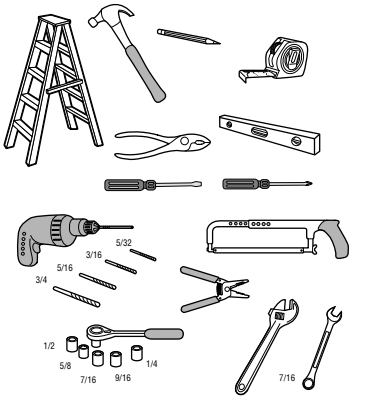
Carton Inventory
Save the carton and packing material until the installation and adjustment is complete. Instructions for the accessories will be attached to the accessory and are not included in this manual. The images throughout this manual are for reference only and your product may look different.

A. Header bracket
B. Pulley
C. Door bracket
D. Curved door arm
E. Straight door arm
(Packaged inside front rail section)
F. Trolley
NOTE: Be sure to assemble the trolley before sliding onto rail.
G. Emergency release rope and handle
H. Rail (1 front and 4 center sections)
I. Hanging brackets (2)
(Packaged inside the front rail section)
J. Garage door opener (motor unit)
K. Sprocket cover and screws
L. “U” bracket
M. Belt
N. Door Control
O. Remote control
P. The Protector System®
Safety reversing sensors with 2 conductor white and white/black wire attached: Sending Sensor (1), Receiving Sensor (1), and Safety Sensor Brackets (2)
Q. Automatic Garage Door Lock
NOT SHOWN
Wireless keypad
White and red/white wire
Owner’s manual
Hardware
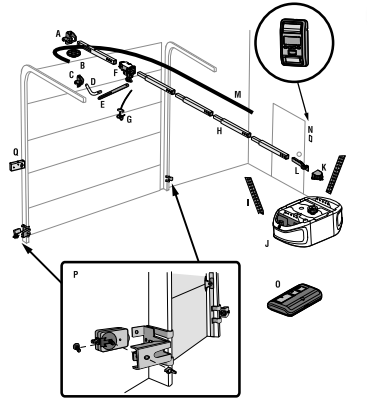
Hardware

Assembly
STEP 2 Fasten the rail to the motor unit

- Insert a 1/4″-20 x 1-3/4″ bolt into the cover protection bolt hole on the back end of the rail as shown. Tighten securely with a 1/4″-20 lock nut. DO NOT overtighten.
- Remove the bolts from the top of the motor unit.
- Use the carton to support the front end of the rail.
- Place the “U” bracket, flat side down onto the motor unit and align the bracket holes with the bolt holes.
- Fasten the “U” bracket with the previously removed bolts; DO NOT use any power tools. The use of power tools may permanently damage the garage door opener.
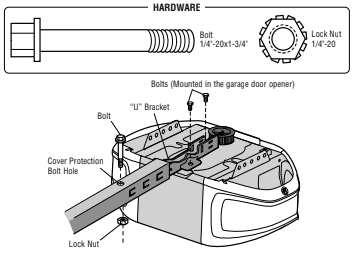
STEP 3 Install the idler pulley
- Lay the belt beside the rail, as shown. Grasp the end with the hooked trolley connector and pass approximately 12″ (30 cm) of belt through the window. Keep the ribbed side toward the rail, and allow it to hang until Assembly Step 4.
- Remove the tape from the idler pulley. The inside center should be pre-greased. If dry, regrease to ensure proper operation.
- Place the idler pulley into the window as shown.
- Insert the idler bolt from the top through the rail and pulley. Tighten with a 3/8″ lock washer and nut underneath the rail until the lock washer is compressed.
- Rotate the pulley to be sure it spins freely.
- Locate the rail tab. The rail tab is between the idler bolt and the trolley in the front rail section. Use a flathead screwdriver and lift the rail tab until the tab is vertical (90o).
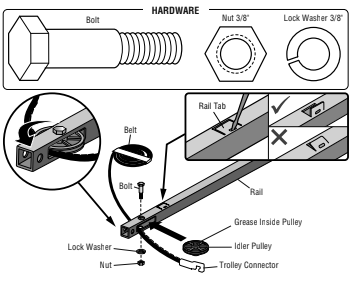
STEP 4 Install the belt
- Pull the belt around the idler pulley and toward the trolley. The ribbed side must contact the pulley.
- Hook the trolley connector into the retaining slot on the trolley as shown (Figure 1).
- With the trolley against the screwdriver, dispense the remainder of the belt along the rail length toward the motor unit and around the sprocket (Figure 2). The sprocket teeth must engage the belt.
- Check to make sure the belt is not twisted. Connect the trolley threaded shaft with the master link (Figure 3).
– Push pins of master link bar through holes in end of belt and trolley threaded shaft.
– Push master link cap over pins and past pin notches.
– Slide the closed end of the clip-on spring over one of the pins. Push the open end of the clip-on spring onto the other pin. - Remove the spring trolley nut from the threaded shaft.
- Insert the trolley threaded shaft through the hole in the trolley.
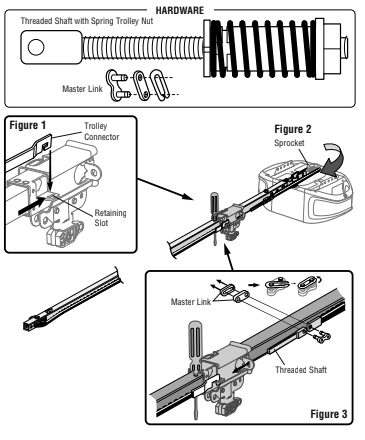
STEP 5 Tighten the belt
- By hand, thread the spring trolley nut on the threaded shaft until it is finger tight against the trolley. Do not use any tools. Remove the screwdriver.
- Insert a flathead screwdriver tip into one of the nut ring slots and brace it firmly against the trolley.
- Tighten the spring trolley nut with an adjustable wrench or a 7/16″ open end wrench about a quarter turn until the spring releases and snaps the nut ring against the trolley. This sets the spring to optimum belt tension.
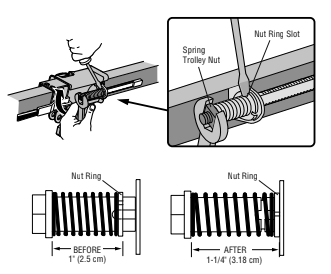
STEP 6 Install the sprocket cover

– ALWAYS keep hand clear of sprocket while operating opener.
– Securely attach sprocket cover BEFORE operating.
- Position the sprocket cover over the sprocket as shown and fasten to the mounting plate with 8×3/8″ hex screws provided.
You have now finished assembling your garage door opener. Please read the following warnings before proceeding to the installation section.
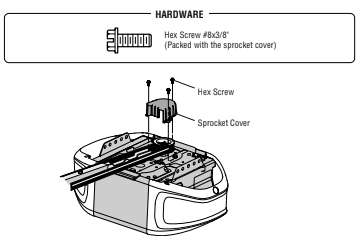
IMPORTANT INSTALLATION INSTRUCTIONS

To reduce the risk of SEVERE INJURY or DEATH:
- READ AND FOLLOW ALL INSTALLATION WARNINGS AND INSTRUCTIONS.
- Install garage door opener ONLY on properly balanced and lubricated garage door. An improperly balanced door may NOT reverse when required and could result in SEVERE INJURY or DEATH.
- ALL repairs to cables, spring assemblies and other hardware MUST be made by a trained door systems technician BEFORE installing opener.
- Disable ALL locks and remove ALL ropes connected to garage door BEFORE installing opener to avoid entanglement.
- Where possible, install the door opener 7 feet (2.13 m) or more above the floor.
- Mount the emergency release within reach, but at least 6 feet (1.83 m) above the floor and avoiding contact with vehicles to avoid accidental release.
- NEVER connect garage door opener to power source until instructed to do so.
- NEVER wear watches, rings or loose clothing while installing or servicing opener. They could be caught in garage door or opener mechanisms.
- Install wall-mounted garage door control:
– within sight of the garage door.
– out of reach of small children at a minimum height of 5 feet (1.5 m) above floors, landings, steps or any other adjacent walking surface.
– away from ALL moving parts of the door. - Place entrapment warning label on wall next to garage door control.
- Place emergency release/safety reverse test label in plain view on inside of garage door.
- Upon completion of installation, test safety reversal system. Door MUST reverse on contact with a 1-1/2″ (3.8 cm) high object (or a 2×4 laid flat) on the floor.
- To avoid SERIOUS PERSONAL INJURY or DEATH from electrocution, disconnect ALL electric and battery power BEFORE performing ANY service or maintenance.
- DO NOT install on a one-piece door if using devices or features providing unattended close. Unattended devices and features are to be used ONLY with sectional doors.
STEP 1 Determine the header bracket location

– Header bracket MUST be RIGIDLY fastened to structural support on header wall or ceiling, otherwise
garage door might NOT reverse when required. DO NOT install header bracket over drywall.
– Concrete anchors MUST be used if mounting header bracket or 2×4 into masonry.
– NEVER try to loosen, move or adjust garage door, springs, cables, pulleys, brackets, or their hardware, ALL of which are under EXTREME tension.
– ALWAYS call a trained door systems technician if garage door binds, sticks, or is out of balance. An unbalanced garage door might NOT reverse when required.
Installation procedures vary according to garage door types. Follow the instructions which apply to your door.
- Close the door and mark the inside vertical centerline of the garage door.
- Extend the line onto the header wall above the door.You can fasten the header bracket within 4 feet (1.22 m) of the left or right of the door center only if a torsion spring or center bearing plate is in the way; or you can attach it to the ceiling (see page 12) when clearance is minimal. (It may be mounted on the wall upside down if necessary, to gain approximately 1/2″ (1 cm). If you need to install the header bracket on a 2×4 (on wall or ceiling), use lag screws (not provided) to securely fasten the 2×4 to structural supports as shown here and on page 12.
- Open your door to the highest point of travel as shown. Draw an intersecting horizontal line on the header wall 2″ (5 cm) above the high point:
– 2″ (5 cm) above the high point for sectional door and one-piece door with track.
– 8″ (20 cm) above the high point for one-piece door without track.
This height will provide travel clearance for the top edge of the door. NOTE: If the total number of inches exceeds the height available in your garage, use the maximum height possible, or refer to page 12 for ceiling installation.
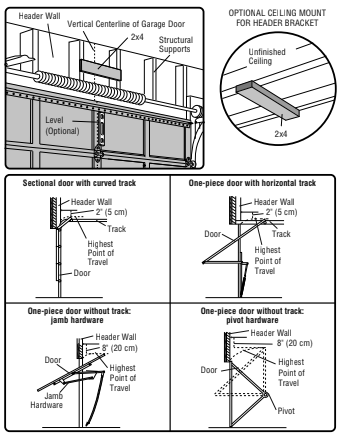
STEP 2 Install the header bracket
You can attach the header bracket either to the wall above the garage door, or to the ceiling. Follow the instructions which will work best for your particular requirements. Do not install the header bracket over drywall. If installing into masonry, use concrete anchors (not provided).

OPTION A – WALL INSTALLATION
- Center the bracket on the vertical centerline with the bottom edge of the bracket on the horizontal line as shown (with the arrow pointing toward the ceiling).
- Mark the vertical set of bracket holes. Drill 3/16″ pilot holes and fasten the bracket securely to a structural support with the hardware provided.

OPTION B – CEILING INSTALLATION
- Extend the vertical centerline onto the ceiling as shown.
- Center the bracket on the vertical mark, no more than 6″ (15 cm) from the wall. Make sure the arrow is pointing away from the wall. The bracket can be mounted flush against the ceiling when clearance is minimal.
- Mark the side holes. Drill 3/16″ pilot holes and fasten bracket securely to a structural support with the hardware provided.
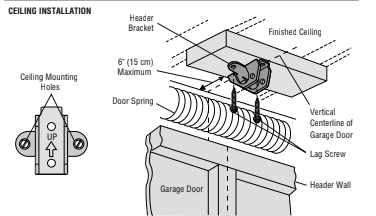
STEP 3 Attach the rail to the header bracket
- Position the opener on the garage floor below the header bracket. Use packing material as a protective base.
NOTE: If the door spring is in the way, you will need help. Have someone hold the opener securely on a temporary support to allow the rail to clear the spring. - Position the rail bracket against the header bracket.
- Align the bracket holes and join with a clevis pin as shown.
- Insert a ring fastener to secure.
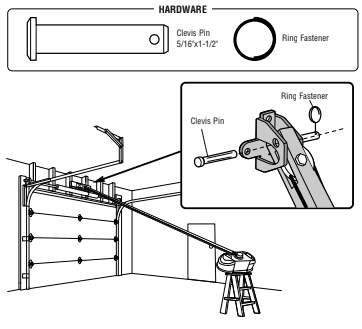
STEP 4 Position the garage door opener

- Remove the packing material and lift the garage door opener onto a ladder.
- Fully open the door and place a 2×4 (laid flat) under the rail. For one-piece doors without tracks, lay the 2×4 on it’s side.
NOTE: A 2×4 is ideal for setting the distance between the rail and the door. If the ladder is not tall enough you will need help at this point. If the door hits the trolley when it is raised, pull the trolley release arm down to disconnect the inner and outer trolley. Slide the outer trolley toward the garage door opener. The trolley can remain disconnected until instructed.
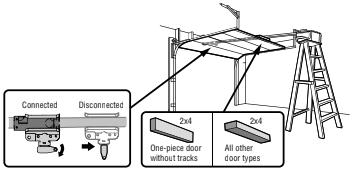
STEP 5 Hang the garage door opener

supports of the garage. Concrete anchors MUST be used if installing ANY brackets into masonry.
Hanging the garage door opener will vary depending on your garage. Below are three example installations. Your
installation may be different. For ALL installations the garage door opener MUST be connected to structural supports.
The instructions illustrate one of the examples below.
- On finished ceilings, use the lag screws to attach a support bracket (not provided) to the structural supports before installing the garage door opener.
- Make sure the garage door opener is aligned with the header bracket. Measure the distance from each side of the garage door opener to the support bracket.
- Cut both pieces of the hanging bracket to required lengths.
- Attach the end of each hanging bracket to the support bracket with appropriate hardware (not provided).
- Attach the garage door opener to the hanging brackets with the hex bolts, lock washers, and nuts.
- Remove the 2×4 and manually close the door. If the door hits the rail, raise the header bracket.
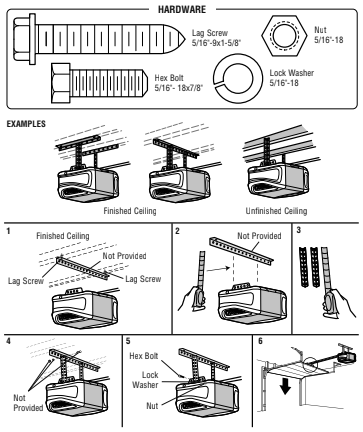
STEP 6 Install the Light Bulbs

– Use ONLY A19 incandescent (100W maximum) or compact fluorescent (26W maximum) light bulbs.
– DO NOT use incandescent bulbs larger than 100W.
– DO NOT use compact fluorescent light bulbs larger than 26W (100W equivalent).
– DO NOT use halogen bulbs.
– DO NOT use short neck or specialty light bulbs.
- Pull on the top sides of the light lens and rotate the light lens down.
- Insert an A19 incandescent (100W maximum) or compact fluorescent (26W, 100W equivalent) light bulb into the light socket.
- Rotate the lens up to close.
NOTE: Do not use halogen, short neck, or specialty light bulbs as these may overheat the end panel or light socket.
Do not use LED bulbs as they may reduce the range or performance of your remote controls.
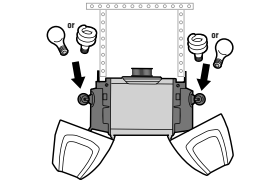
STEP 7 Attach the emergency release rope and handle

– If possible, use emergency release handle to disengage trolley ONLY when garage door is CLOSED. Weak or broken springs or unbalanced door could result in an open door falling rapidly and/or unexpectedly.
– NEVER use emergency release handle unless garage doorway is clear of persons and obstructions.
– NEVER use handle to pull door open or closed. If rope knot becomes untied, you could fall.
- Insert one end of the emergency release rope through the handle. Make sure that “NOTICE” is right side up. Secure with an overhand knot at least 1″ (2.5 cm) from the end of the rope to prevent slipping.
- Insert the other end of the emergency release rope through the hole in the trolley release arm. Mount the emergency release within reach, but at least 6 feet (1.83 m) above floor, avoiding contact with vehicles to prevent accidental release and secure with an overhand knot.
NOTE: If it is necessary to cut the emergency release rope, seal the cut end with a match or lighter to prevent unraveling. Ensure the emergency release rope and handle are above the top of all vehicles to avoid entanglement.
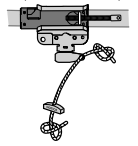
STEP 8 Install the door bracket

A horizontal and vertical reinforcement is needed for lightweight garage doors (fiberglass, aluminum, steel, doors with glass panel, etc.) (not provided). A horizontal reinforcement brace should be long enough to be secured to two or three vertical supports. A vertical reinforcement brace should cover the height of the top panel. Contact the garage door manufacturer or installing dealer for opener reinforcement instructions or reinforcement kit.
NOTE: Many door reinforcement kits provide for direct attachment of the clevis pin and door arm. In this case you will not need the door bracket; proceed to the next step.
OPTION A – SECTIONAL DOORS
- Center the door bracket on the previously marked vertical centerline used for the header bracket installation. Note correct UP placement, as stamped inside the bracket.
- Position the top edge of the bracket 2″-4″ (5-10 cm) below the top edge of the door, OR directly below any structural support across the top of the door.
- Mark, drill holes and install as follows, depending on your door’s construction.
Metal or light weight doors using a vertical angle iron brace between the door panel support and the door bracket:
– Drill 3/16″ fastening holes. Secure the door bracket using the two 1/4″-14×5/8″ self-threading screws. (Figure 1)
– Alternately, use two 5/16″-18×2″ bolts, lock washers and nuts (not provided). (Figure 2)
Metal, insulated or light weight factory reinforced doors:
– Drill 3/16″ fastening holes. Secure the door bracket using the self-threading screws. (Figure 3)
Wood doors:
– Use top and bottom or side to side door bracket holes. Drill 5/16″ holes through the door and secure bracket with 5/16″-18×2″ carriage bolts, lock washers and nuts (not provided). (Figure 4)
NOTE: The 1/4″-14×5/8″ self-threading screws are not intended for use on wood doors.
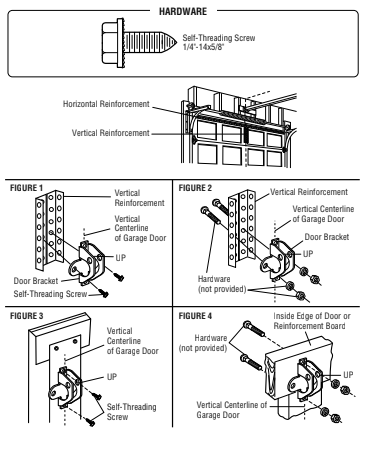
OPTION B – ONE-PIECE DOORS
- Center the door bracket on the top of the door, in line with the header bracket as shown.
- Mark either the left and right, or the top and bottom holes.
Metal Doors:
– Drill 3/16″ pilot holes and fasten the bracket with the self-threading screws provided.
Wood Doors:
– Drill 5/16″ holes and use 5/16″-18×2″ carriage bolts, lock washers and nuts (not provided) or 5/16″x1-1/2″ lag screws (not provided) depending on your installation needs.
NOTE: The door bracket may be installed on the top edge of the door if required for your installation. (Refer to the dotted line optional placement drawing.)

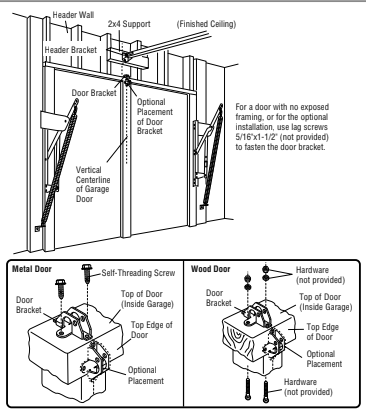
STEP 9 Connect the door arm to the trolley
Installation will vary according to the garage door type. Follow the instructions which apply to your door.
OPTION A – SECTIONAL DOORS
IMPORTANT: The groove on the straight door arm MUST face away from the curved door arm.
- Close the door. Disconnect the trolley by pulling the emergency release handle.
- Attach the straight door arm to the outer trolley using the clevis pin. Secure with the ring fastener.
- Attach the curved door arm to the door bracket using the clevis pin. Secure with the ring fastener.
- Bring arm sections together. Find two pairs of holes that line up and join sections. Select holes as far apart as possible to increase door arm rigidity and attach using the bolts, nuts, and lock washers.
- Pull the emergency release handle toward the garage door opener until the trolley release arm is horizontal. The trolley will re-engage automatically when the garage door opener is activated.
NOTE: If the holes in the curved door arm and the straight door arm do not align, reverse the straight door arm, select two holes (as far apart as possible) and attach using bolts, nuts, and lock washers. If the straight door arm is hanging down too far, you may cut 6 inches (15 cm) from the solid end.
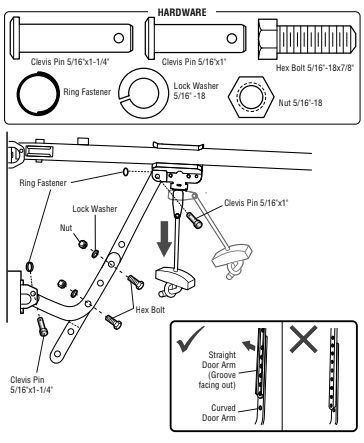
OPTION B – ONE-PIECE DOORS
IMPORTANT: The groove on the straight door arm MUST face away from the curved door arm.
- Close the door. Disconnect the trolley by pulling the emergency release handle.
- Fasten the straight door arm and the curved door arm together to the longest possible length (with a 2 or 3 hole overlap) using the bolts, nuts, and lock washers.
- Attach the straight door arm to the door bracket using the clevis pin. Secure with the ring fastener.
- Attach the curved door arm to the trolley using the clevis pin. Secure with the ring fastener.
- Pull the emergency release handle toward the garage door opener until the trolley release arm is horizontal.
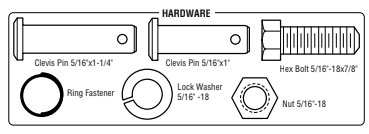
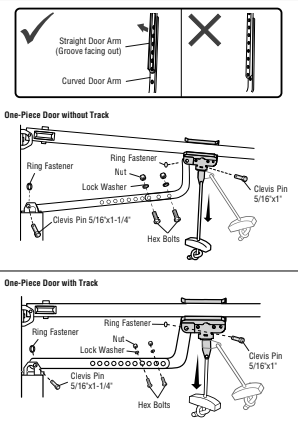
STEP 10 Install the door control

– Be sure power is NOT connected BEFORE installing door control.
– Connect door control ONLY to 12 VOLT low voltage wires.
To prevent possible SERIOUS INJURY or DEATH from a closing garage door:
– Install door control within sight of garage door, out of reach of small children at a minimum height of 5 feet (1.5 m) above floors, landings, steps or any other adjacent walking surface, and away from ALL moving parts of door.
– NEVER permit children to operate or play with door control push buttons or remote control transmitters.
– Activate door ONLY when it can be seen clearly, is properly adjusted, and there are no obstructions to door travel.
– ALWAYS keep garage door in sight until completely closed. NEVER permit anyone to cross path of closing garage door.
INTRODUCTION
Older Chamberlain door controls and third party products are not compatible. Install the door control within sight of the door at a minimum height of 5 feet (1.5 m) above floors, landings, steps or any other adjacent walking surface, where small children cannot reach, and away from the moving parts of the door. For gang box installations it is not necessary to drill holes or install the drywall anchors. Use the existing holes in the gang box.
NOTE: Your product may look different than the illustrations.

- Strip 7/16 inch (11 mm) of insulation from one end of the wire and separate the wires.
- Connect one wire to each of the two screws on the back of the door control. The wires can be connected to either screw. If your garage is pre-wired for the door control choose any two wires to connect, note which wires are used so the correct wires are connected to the garage door opener in a later step.
- Mark the location of the bottom mounting hole and drill a 5/32 inch hole.
- Install the bottom screw, allowing 1/8 inch (3 mm) to protrude from the wall.
- Position the bottom hole of the door control over the screw and slide down into place.
- Lift the push bar up and mark the top hole.
- Remove the door control from the wall and drill a 5/32 inch hole for the top screw.
- Position the bottom hole of the door control over the screw and slide down into place. Attach the top screw.
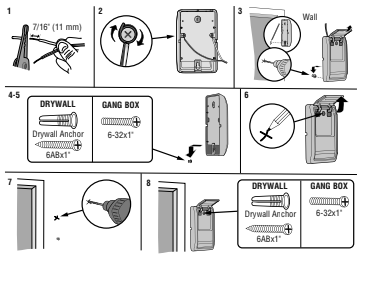
STEP 11 Wire the door control to the garage door opener
- Run the white and red/white wire from the door control to the garage door opener. Attach the wire to the wall and ceiling with the staple (not applicable for gang box or pre-wired installations). Do not pierce the wire with the staple as this may cause a short or an open circuit.
- Strip 7/16 inch (11 mm) of insulation from the end of the wire near the garage door opener.
- Connect the wire to the red and white terminals on the garage door opener. If your garage is pre-wired make sure you use the same wires that are connected to the door control. To insert or release wires from the terminal, push in the tab with screwdriver tip.
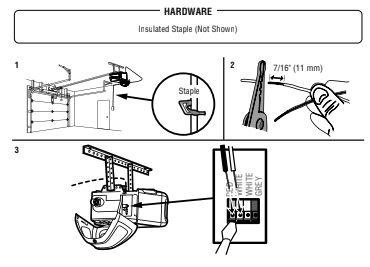
STEP 12 Attach the warning labels
- Attach the entrapment warning label on the wall near the door control with tacks or staples.
- Attach the manual release/safety reverse test label in a visible location on the inside of the garage door.
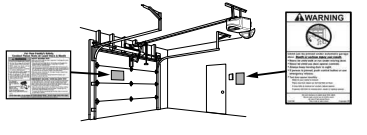
STEP 13 Install the Protector System®

To prevent SERIOUS INJURY or DEATH from closing garage door:
– Correctly connect and align the safety reversing sensor. This required safety device MUST NOT be
disabled.
– Install the safety reversing sensor so beam is NO HIGHER than 6″ (15 cm) above garage floor.
IMPORTANT INFORMATION ABOUT THE SAFETY REVERSING SENSORS
The safety reversing sensors must be connected and aligned correctly before the garage door opener will move in the down direction.
The sending sensor (with an amber LED) transmits an invisible light beam to the receiving sensor (with a green LED). If an obstruction breaks the light beam while the door is closing, the door will stop and reverse to the full open position, and the garage door opener lights will flash 10 times.
NOTE: For energy efficiency the garage door opener will enter sleep mode when the door is fully closed. The sleep mode shuts the garage door opener down until activated. The sleep mode is sequenced with the garage door opener light bulb; as the light bulb turns off the sensor LEDs will turn off and whenever the garage door opener lights turn on the sensor LEDs will light. The garage door opener will not go into the sleep mode until the garage door opener has
completed 5 cycles upon power up.
When installing the safety reversing sensors check the following:
– Sensors are installed inside the garage, one on either side of the door.
– Sensors are facing each other with the lenses aligned and the receiving sensor lens does not receive direct sunlight.
– Sensors are no more than 6 inches (15 cm) above the floor and the light beam is unobstructed.


The safety reversing sensors can be attached to the door track, the wall, or the floor. The sensors should be no more than 6 inches (15 cm) above the floor. If the door track will not support the sensor bracket a wall installation is recommended. Choose one of the following installations.
OPTION A – DOOR TRACK INSTALLATION
- Slide the curved arms of the sensor bracket around the edge of the door track. Snap into place so that the sensor bracket is flush against the track.
- Slide the carriage bolt into the slot on each sensor.
- Insert the bolt through the hole in the sensor bracket and attach with the wing nut. The lenses on both sensors should point toward each other. Make sure the lens is not obstructed by the sensor bracket.
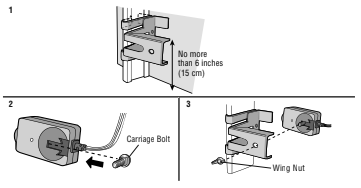
OPTION B – WALL INSTALLATION
If additional clearance is needed an extension bracket (not provided) or wood blocks can be used. Make sure each bracket has the same amount of clearance so they will align correctly.
- Position the sensor bracket against the wall with the curved arms facing the door. Make sure there is enough clearance for the beam to be unobstructed. Mark holes.
- Drill 3/16 inch pilot holes for each sensor bracket and attach the sensor brackets to the wall using lag screws (not provided).
- Slide the carriage bolt into the slot on each sensor.
- Insert the bolt through the hole in the sensor bracket and attach with the wing nut. The lenses on both sensors should point toward each other. Make sure the lens is not obstructed by the sensor bracket.
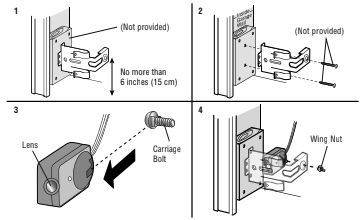
OPTION C – FLOOR INSTALLATION
Use an extension bracket (not provided) or wood block to raise the sensor bracket if needed.
- Carefully measure the position of both sensor brackets so they will be the same distance from the wall and unobstructed.
- Attach the sensor brackets to the floor using concrete anchors (not provided).
- Slide the carriage bolt into the slot on each sensor.
- Insert the bolt through the hole in the sensor bracket and attach with the wing nut. The lenses on both sensors should point toward each other. Make sure the lens is not obstructed by the sensor bracket.
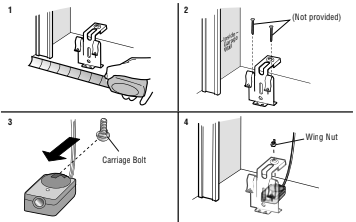
STEP 14 Wire the Safety Reversing Sensors
If your garage already has wires installed for the safety reversing sensors, proceed to page next
OPTION A – INSTALLATION WITHOUT PRE-WIRING
- Run the wire from both sensors to the garage door opener. Attach the wire to the wall and ceiling with the staples.
- Strip 7/16 inch (11 mm) of insulation from each set of wires. Separate the wires. Twist the white wires together. Twist the white/black wires together.
- Insert the white wires into the white terminal on the garage door opener. Insert the white/black wires into the grey terminal on the garage door opener. To insert or remove the wires from the terminal, push in the tab with a screwdriver tip.
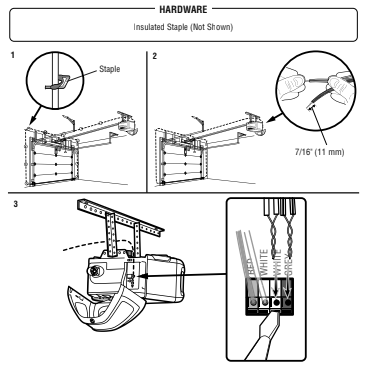
OPTION B – PRE-WIRED INSTALLATION
- Cut the end of the safety reversing sensor wire, making sure there is enough wire to reach the pre-installed wires from the wall.
- Separate the safety reversing sensor wires and strip 7/16 inch (11 mm) of insulation from each end.
Choose two of the pre-installed wires and strip 7/16 inch (11 mm) of insulation from each end. Make sure that you choose the same color pre-installed wires for each sensor. - Connect the pre-installed wires to the sensor wires with wire nuts making sure the colors correspond for each sensor. For example, the white wire would connect to the yellow wire and the white/black wire would connect to the purple wire.
- At the garage door opener, strip 7/16 inch (11 mm) of insulation from each end of the wires previously chosen for the safety reversing sensors. Twist the like-colored wires together.
- Insert the wires connected to the white safety sensor wires to the white terminal on the garage door opener.
Insert the wires that are connected to the white/black safety sensor wires to the grey terminal on the garage door opener.
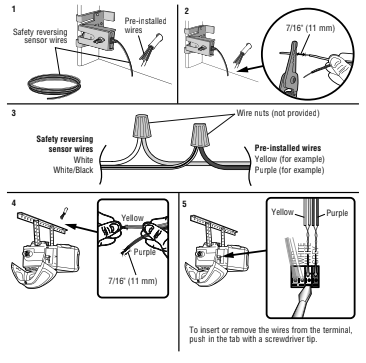
STEP 15 Install the Automatic Garage Door Lock
For use on Residential Garages with an Entry Door Only. Install On Sectional Doors with Torsion Assemblies Only. Up to two locks can be installed per compatible garage door opener.

– Automatic Garage Door Lock MUST be installed per the owner’s manual.
– Be sure to DISCONNECT ALL ELECTRIC AND BATTERY POWER to the garage door opener BEFORE
installing the garage door lock.
– The door MUST be in the fully opened or closed position BEFORE installing the garage door lock.
– Be sure to DISASSEMBLE and REMOVE any manual door locks that might be currently installed.
UNPLUG THE GARAGE DOOR OPENER AND DISCONNECT THE BATTERY (IF APPLICABLE) BEFORE PROCEEDING. REMOVE ANY MANUAL LOCKS FROM THE GARAGE DOOR.
- Attach template (provided) to track. TIP: The second roller from the bottom is ideal for most installations.
- Drill holes as marked on template. Use a 3/4″ step drill bit to drill holes as marked on the template.
OR
If not using a step drill bit, pre-drill with a smaller drill bit to assure proper placement of the 3/4″ hole. - Fasten automatic garage door lock to the outside of the garage door track with the 1/4″-20×1/2″ screws.
- Run wire (provided) from automatic garage door lock to garage door opener. Use insulated staples (not provided) to secure wire in several places. NOTE: If you are going to cut the wire you will need to reconnect wire using a wire nut. Do not tape the ends together. The lock is polarized and requires you
reconnect black to black and white to white wires. - Plug the connector into one of the lock terminals on the garage door opener. NOTE: To install a second automatic garage door lock, repeat installation steps on the opposite side of the garage door.
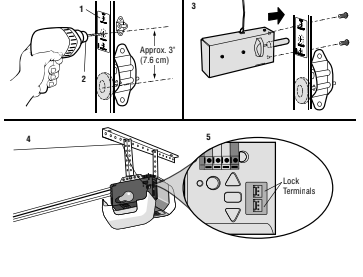
STEP 16 Connect power

– Be sure power is NOT connected to the opener, and disconnect power to circuit BEFORE removing cover to establish permanent wiring connection.
– Garage door installation and wiring MUST be in compliance with ALL local electrical and building codes.
– NEVER use an extension cord, 2-wire adapter, or change plug in ANY way to make it fit outlet. Be sure the opener is grounded.
To avoid installation difficulties, do not run the opener at this time.
To reduce the risk of electric shock, your garage door opener has a grounding type plug with a third grounding pin. This plug will only fit into a grounding type outlet. If the plug doesn’t fit into the outlet you have, contact a qualified electrician to install the proper outlet.

THERE ARE TWO OPTIONS FOR CONNECTING POWER:
OPTION A – TYPICAL WIRING
- Plug in the garage door opener into a grounded outlet.
- DO NOT run garage door opener at this time.
OPTION B – PERMANENT WIRING
If permanent wiring is required by your local code, refer to the following procedure. To make a permanent
connection through the 7/8 inch hole in the top of the motor unit (according to local code):
- Remove the motor unit cover screws and set the cover aside.
- Remove the attached 3-prong cord.
- Connect the black (line) wire to the screw on the brass terminal; the white (neutral) wire to the screw on the silver terminal; and the ground wire to the green ground screw. The opener must be grounded.
- Reinstall the cover.
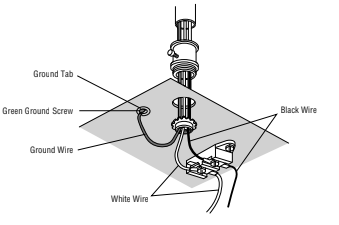
STEP 17 Aligning the safety reversing sensors
The door will not close if the sensors have not been installed and aligned correctly.
When the light beam is obstructed or misaligned while the door is closing, the door will reverse and the garage door opener lights will flash ten times. If the door is already open, it will not close.
- Check to make sure the LEDs in both sensors are glowing steadily. The LEDs in both sensors will glow steadily if they are aligned and wired correctly.
The sensors can be aligned by loosening the wing nuts, aligning the sensors, and tightening the wing nuts.
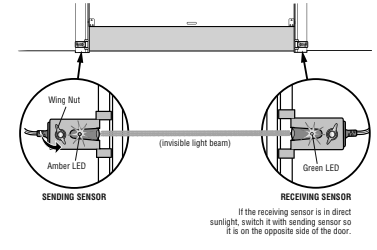
IF THE AMBER LED ON THE SENDING SENSOR IS NOT GLOWING:
- Make sure there is power to the garage door opener.
- Make sure the sensor wire is not shorted/broken.
- Make sure the sensor has been wired correctly: white wires to white terminal and white/black wires to grey terminal.

IF THE GREEN LED ON THE RECEIVING SENSOR IS NOT GLOWING:
- Make sure the sensor wire is not shorted/broken.
- Make sure the sensors are aligned.

STEP 18 Ensure the door control is wired correctly
If the door control has been installed and wired correctly, a message will display on the Smart Control Panel screen.
Adjustments
Introduction

– Incorrect adjustment of garage door travel limits will interfere with proper operation of safety reversal
system.
– After ANY adjustments are made, the safety reversal system MUST be tested. Door MUST reverse on
contact with 1-1/2″ (3.8 cm) high object (or 2×4 laid flat) on floor.

Your garage door opener is designed with electronic controls to make setup and adjustments easy. The adjustments allow you to program where the door will stop in the open (UP) and close (DOWN) position. The electronic controls sense the amount of force required to open and close the door. The force is adjusted automatically when you program the travel.
NOTE: If anything interferes with the door’s upward travel it will stop. If anything interferes with the door’s downward travel, it will reverse.
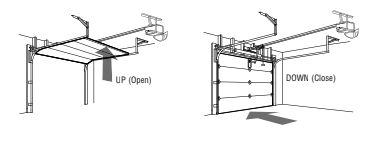
One-Piece Doors Only
When setting the UP travel for a one-piece door ensure that the door does not slant backwards when fully open (UP).
If the door is slanted backwards this will cause unnecessary bucking and/or jerking when the door is opening or closing.

Programming Buttons
The programming buttons are located on the left side panel of the garage door opener and are used to program the travel. While programming, the UP and DOWN buttons can be used to move the door as needed.
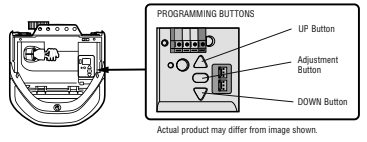
STEP 1 Program the Travel

– Incorrect adjustment of garage door travel limits will interfere with proper operation of safety reversal
system.
– After ANY adjustments are made, the safety reversal system MUST be tested. Door MUST reverse on
contact with 1-1/2″ (3.8 cm) high object (or 2×4 laid flat) on floor.
While programming, the UP and DOWN buttons can be used to move the door as needed.
- Press and hold the Adjustment Button until the UP Button begins to flash and/or a beep is heard.
- Press and hold the UP Button until the door is in the desired UP position.
- Once the door is in the desired UP position press and release the Adjustment Button. The garage door opener lights will flash twice and the DOWN Button will begin to flash. IMPORTANT NOTE: For one- piece door installations refer to page before
- Press and hold the DOWN button until the door is in the desired DOWN position.
- Once the door is in the desired DOWN position press and release the Adjustment Button. The garage door opener lights will flash twice and the UP Button will begin to flash.
- Press and release the UP Button. When the door travels to the programmed UP position, the DOWN Button will begin to flash.
- Press and release the DOWN Button. The door will travel to the programmed DOWN position.
Programming is complete.
- If the garage door opener lights are flashing 5 times during the steps for Program the Travel, the programming has timed out. If the garage door opener lights are flashing 10 times during the steps for Program the Travel, the safety reversing sensors are misaligned or obstructed (refer to page 28). When the sensors are aligned and unobstructed, cycle the door through a complete up and down cycle using the remote control or the UP and DOWN buttons.
Programming is complete. If you are unable to operate the door up and down, repeat the steps for Programming the Travel.
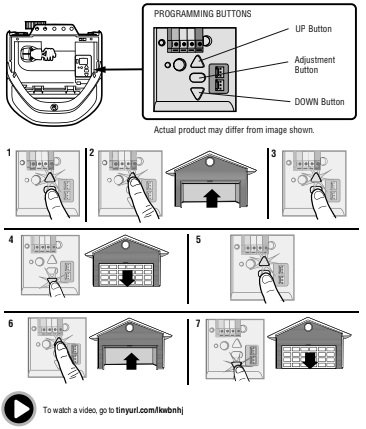
STEP 2 Test the Safety Reversal System

– Safety reversal system MUST be tested every month.
– After ANY adjustments are made, the safety reversal system MUST be tested. Door MUST reverse on
contact with 1-1/2″ (3.8 cm) high object (or 2×4 laid flat) on the floor.
- With the door fully open, place a 1-1/2 inch (3.8 cm) board (or a 2×4 laid flat) on the floor, centered under the garage door.
- Press the remote control push button to close the door. The door MUST reverse when it makes contact with the board.
If the door stops but does not reverse:
- Review the installation instructions provided to insure all steps were followed;
- Repeat Program the Travel (see Adjustment Step 1);
- Repeat the Safety Reversal test.
If the test continues to fail, call a trained door systems technician.
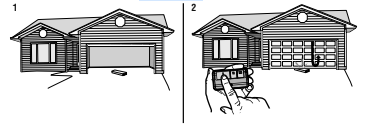
STEP 3 Test the Protector System®

- Open the door. Place the garage door opener carton in the path of the door.
- Press the remote control push button to close the door. The door will not move more than an inch (2.5 cm), and the garage door opener lights will flash 10 times.
The garage door opener will not close from a remote control if the LED in either safety reversing sensor is off (alerting you to the fact that the sensor is misaligned or obstructed). If the garage door opener closes the door when the safety reversing sensor is obstructed (and the sensors are no more than 6 inches [15 cm] above the floor), call for a trained door systems technician.
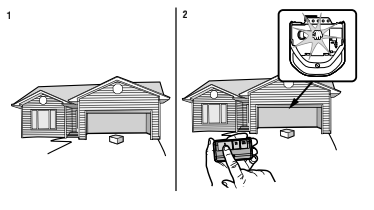
Battery Backup
STEP 1 Install the Battery

– Disconnect ALL electric and battery power BEFORE performing ANY service or maintenance.
– Use ONLY Chamberlain part # 41A6357-1 for replacement battery.
– DO NOT dispose of battery in fire. Battery may explode. Check with local codes for disposal instructions.

compartment.
The battery backup allows access in and out of your garage, even when the power is out. The battery does not have to be fully charged to operate the garage door opener. When the garage door opener is operating on battery power, it will run slower and the battery status LED will glow solid orange, a beep will sound approximately every 2 seconds. The following features are unavailable when operating on battery power:
– Garage Door Opener Lights
– Unattended close devices and features (e.g. MyQ® Smartphone Control and Timer-to-Close)

- Unplug the garage door opener.
- Open the light lens on the right side panel of the garage door opener. Use a Phillips head screwdriver to remove the battery cover on the garage door opener.
- Partially insert the battery into the battery compartment with the terminals facing out.
- Connect red (+) and black (-) wires from the garage door opener to the corresponding terminals on the battery.
- Replace the battery cover.
- Plug in the garage door opener.
- Wait for the green Battery Status LED to start flashing before proceeding to test the battery.
STEP 2 Test the Battery
- Unplug the garage door opener. The battery status LED will either glow solid orange indicating opener is operating on battery power or will flash indicating low battery power. NOTE: Make sure the garage door opener is unplugged.
- Open and close the door using the remote control or door control. The garage door opener may run slower if the battery is not fully charged. The battery will take 24 hours to fully charge.
- Plug in the garage door opener. Verify the battery status LED is flashing green, indicating the battery is charging.

Charge the Battery
The battery charges when the garage door opener is plugged into a 120Vac electrical outlet that has power and requires 24 hours to fully charge. A fully charged battery supplies 12Vdc to the garage door opener for one to two days of normal operation during an electrical power outage. After the electrical power has been restored, the battery will recharge within 24 hours. The battery will last approximately 1 to 2 years with normal usage. Instructions for replacement are provided with the battery. To obtain maximum battery life and prevent damage, disconnect the battery when the garage door opener is unplugged for an extended period of time, such as a summer or winter home.
NOTE: When the garage door opener is in battery backup mode the garage door opener lights, Timer-to-Close, and Remote Close features are unavailable.
In battery backup mode, the Automatic Garage Door Lock will unlock when the garage door is opened, and will remain disabled until power is restored.
MyQ® Smartphone Control
Get Connected
…and control your garage door opener with the MyQ® App.
You will need:
– A smartphone or tablet
– Broadband Internet connection
– A strong Wi-Fi signal (2.4 Ghz, 802.11b/g/n required) in the garage, see page 3
– Password for your home network
– MyQ® serial number located on the garage door opener
1. ACTIVATE “Wi-Fi LEARN” MODE
Press and release the yellow LEARN button on the garage door opener 3 times. The garage door opener will beep once and a blue light will flash. You have 20 minutes to complete the connection process.

2. CONNECT TO THE MyQ® Wi-Fi NETWORK
On your mobile device, go to Settings > Wi-Fi, and select the network with the “MyQ-” prefix.

3. CONNECT THE GARAGE DOOR OPENER TO YOUR HOME Wi-Fi NETWORK
Launch the web browser (such as Safari or Chrome) on your mobile device and go to “setup.myqdevice.com”. Follow the on-screen prompts to add the garage door opener to your home Wi-Fi network.

4. SETUP YOUR MyQ® ACCOUNT
Download the MyQ® app from the App StoreSM or Google PlayTM store. Sign up for your MyQ® account and add the MyQ® serial number to your account.

Congratulations you’ve successfully completed the setup. Enjoy MyQ® Smartphone Control!
In addition to controlling your garage door opener you can control your house lighting with additional MyQ® accessories, see page 42.
NOTES:
The MyQ® Smartphone Control WILL NOT work if the garage door opener is operating on battery power.
To erase the Wi-Fi settings, see page 38.
To learn more go to wifihelp.chamberlain.com.
Operation

- READ AND FOLLOW ALL WARNINGS AND INSTRUCTIONS.
- ALWAYS keep remote controls out of reach of children. NEVER permit children to operate or play with garage door control push buttons or remote controls.
- ONLY activate garage door when it can be seen clearly, it is properly adjusted, and there are no obstructions to door travel.
- ALWAYS keep garage door in sight and away from people and objects until completely closed. NO ONE SHOULD CROSS THE PATH OF THE MOVING DOOR.
- NO ONE SHOULD GO UNDER A STOPPED, PARTIALLY OPENED DOOR.
- If possible, use emergency release handle to disengage trolley ONLY when garage door is CLOSED. Use caution when using this release with the door open. Weak or broken springs or unbalanced door could result in an open door falling rapidly and/or unexpectedly and increasing the risk of SEVERE INJURY or DEATH.
- NEVER use emergency release handle unless garage doorway is clear of persons and obstructions.
- NEVER use handle to pull garage door open or closed. If rope knot becomes untied, you could fall.
- After ANY adjustments are made, the safety reversal system MUST be tested.
- Safety reversal system MUST be tested every month. Garage door MUST reverse on contact with 1-1/2″ (3.8 cm) high object (or a 2×4 laid flat) on the floor. Failure to adjust the garage door opener properly increases the risk of SEVERE INJURY or DEATH.
- ALWAYS KEEP GARAGE DOOR PROPERLY BALANCED (see page 2). An improperly balanced door may NOT reverse when required and could result in SEVERE INJURY or DEATH.
- ALL repairs to cables, spring assemblies and other hardware, ALL of which are under EXTREME tension, MUST be made by a trained door systems technician.
- ALWAYS disconnect electric and battery power to garage door opener BEFORE making ANY repairs or removing covers.
- This operator system is equipped with an unattended operation feature. The door could move unexpectedly. NO ONE SHOULD CROSS THE PATH OF THE MOVING DOOR.
- DO NOT install on a one-piece door if using devices or features providing unattended close. Unattended devices and features are to be used ONLY with sectional doors.
- SAVE THESE INSTRUCTIONS.
Using your Garage Door Opener
- The garage door opener can be activated with a wall-mounted door control, remote control, wireless keyless entry, MyQ® Smartphone Control app or MyQ® Garage Door Monitor. When the door is closed and the garage door opener is activated the door will open. If the door senses an obstruction or is interrupted
while opening the door will stop. When the door is in any position other than closed and the garage door opener is activated the door will close. If the garage door opener senses an obstruction while closing, the door will reverse. If the obstruction interrupts the sensor beam the garage door opener lights will blink 10 imes. If the door is fully open, and the safety reversing sensors are not installed, or are misaligned, the door will not close from a remote control, TTC, or the MyQ® Smartphone Control app. However, you can close the door by holding the button on the door control or the ENTER button on the keyless entry until the door is fully closed. - The garage door opener light bulbs will turn on when the opener is initially plugged in; power is restored after interruption, or when the garage door opener is activated. The lights will turn off automatically after 4- 1/2 minutes. The lights will turn on when someone enters through the open garage door and the safety reversing sensor infrared beam is obstructed, see page 36. Use an incandescent A19 light bulb (100W maximum) or for maximum energy efficiency a 26W (100W equivalent) compact fluorescent light (CFL) bulb. NOTE: Do not use halogen, short neck, or specialty light bulbs as these may overheat the end panel or light socket. Do not use LED bulbs as they may reduce the range or performance of your remote controls.
To Open the Door Manually

– If possible, use emergency release handle to disengage trolley ONLY when garage door is CLOSED. Weak or broken springs or unbalanced door could result in an open door falling rapidly and/or unexpectedly.
– NEVER use emergency release handle unless garage doorway is clear of persons and obstructions.
– NEVER use handle to pull door open or closed. If rope knot becomes untied, you could fall.
TO MANUALLY DISENGAGE AUTOMATIC GARAGE DOOR LOCK
- The door should be fully closed if possible.
- Disengage the automatic garage door lock by sliding the manual release to the open position.
- Pull the emergency release handle down and back (toward the garage door opener). The garage door can then be raised and lowered manually as
necessary. - To reconnect the trolley, pull the emergency release handle straight down. The trolley will reconnect on the next UP or DOWN operation.
NOTE: The automatic garage door lock will re-engage when garage door opener operation resumes.

DISCONNECT THE TROLLEY
- The door should be fully closed if possible.
- Pull down on the emergency release handle so the trolley release arm snaps to the vertical position. The door can now be raised and lowered as often as
necessary.
TO RE-CONNECT THE TROLLEY
Pull the emergency release handle toward the garage door opener so the trolley release arm snaps to the horizontal position. The trolley will reconnect
on the next UP or DOWN operation, either manually or by using the door control or remote control.
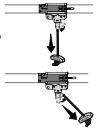
Smart Control Panel®
SYNCHRONIZE THE DOOR CONTROL: To synchronize the door control to the garage door opener, press the push bar until the garage door opener activates (it may take up to 3 presses). Test the door control by pressing the push bar; each press of the push bar will activate the garage door opener.
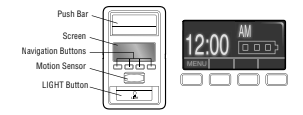
PUSH BAR: Press the push bar to open or close the door.
LIGHT BUTTON: Press the LIGHT button to turn the garage door opener lights on or off. When the lights are turned on they will stay on until the LIGHT button is pressed again, or until the garage door opener is activated. Once the garage door opener is activated the lights will turn off after the specified period of time (the factory default is 4-1/2 minutes). The LIGHT button will not control the lights when the door is in motion. The Light Feature will turn on the light on the garage door opener when someone enters through the open garage door and the safety reversing sensor infrared beam is obstructed.
MOTION SENSOR: The motion sensor automatically turns on the garage door opener lights when motion is detected. The lights come on for the set period of time, and then shut off. If using the garage door opener light as a work light disable the motion sensor, otherwise the lights may turn off automatically if you are beyond the range of the motion sensor.
NAVIGATION AND SCREEN: The screen displays the time, temperature, and current battery charge (if applicable) until the menu button is pressed, and then it will display the menu options. If there is a problem with the garage doors opener the screen will display an error code (diagnostic code, see page 40). The features on the door control can be programmed through a series of menus on the screen. Use the navigation buttons to scroll through the menus and make selections.
MENU OPTIONS

CLOCK SETUP: Set the time; choose 12 or 24 hour clock and show/hide clock.
TEMPERATURE: Display the temperature in Fahrenheit or Celsius and show/hide the temperature.
LANGUAGE: Select English, Spanish or French.
CONTRAST ADJUST: Adjust the screen contrast.
LIGHT SETTINGS:
To change the amount of time the lights stay on:
- Select LIGHT SETTINGS from the menu.
- Select LIGHT TIME.
- Select the time interval.
To turn the Light Feature on or off (Factory default is On):
- Select LIGHT SETTINGS from the menu.
- Select AUTOMATIC LIGHTS.
- Select ENTRY SENSOR.
To turn the motion sensor on or off:
- Select LIGHT SETTINGS from the menu.
- Select AUTOMATIC LIGHTS.
- Select MOTION SENSOR.
LOCK: Prevents the garage door opener from being activated by remote controls while still allowing activation from
the door control and keyless entry.
To turn the LOCK feature ON or OFF:
- Select LOCK from the menu. When the LOCK feature is on, a message displays on the screen.
TIMER-TO-CLOSE (TTC) (Factory default is set to off): The Timer-to-Close feature automatically closes the door after a specified time period and can be adjusted using the door control. DO NOT enable TTC if operating a one-piece door. TTC is to be used ONLY with sectional doors. The garage door opener will beep and the lights will flash before closing the door. The TTC feature will deactivate if the garage door encounters an obstruction twice; or the safety reversing sensors are incorrectly installed. The garage door will reverse open and WILL NOT close until the obstructions are clear or the safety reversing sensors are correctly installed. When the obstruction has been cleared or the safety reversing sensors have been aligned, the door will close when the garage door opener is activated. TTC WILL NOT work if the garage door opener is operating by battery power or if the safety reversing sensors are misaligned. This feature is NOT intended to be the primary method of closing the door. A keyless entry should be installed in the event of an accidental lock out when using this feature.
To turn TTC on or off or to set the TTC time interval:
- Select TTC from the menu.
- Select a time interval of 1, 5, 10 minutes or a custom setting up to 99 minutes. Once the TTC has been set and the door is open, a message will display on the screen with the selected time interval.
To temporarily suspend the TTC feature select HOLD. Select REL to resume normal TTC operation. PROGRAM: Any compatible remote control, wireless keyless entry, or MyQ® devices can be programmed to the garage door using the PROGRAM option from the menu.
Remote Control and Keyless Entry
Pre-programmed remote control included, no need to program the remote.
To add or reprogram a remote control, follow the instructions below. Older Chamberlain remote controls are NOT compatible, see page 42 for compatible accessories.
PROGRAM USING THE DOOR CONTROL
- Press the navigation button below “MENU” to view the Features menu.
- Use the navigation buttons to scroll to “PROGRAM”.
- Select “REMOTE” or “KEYPAD” to program from the program menu.
- Remote Control: Press the button on the remote control that you wish to operate your garage door.
Keyless Entry: Enter a 4-digit personal identification number (PIN) of your choice on the keyless entry keypad. Then press the ENTER button.
The garage door opener lights will flash (or two clicks will be heard) when the code has been programmed. Repeat the steps for programming additional remote controls or keyless entry devices. If programming is unsuccessful, repeat the steps using the learn button on the garage door opener.
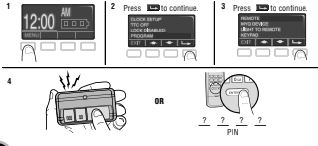
To Erase the Memory
ERASE ALL REMOTE CONTROLS AND KEYLESS ENTRIES
- Press and hold the LEARN button on garage door opener until the learn LED goes out (approximately 6 seconds). All remote control and keyless entry codes are now erased. Reprogram any accessory you wish vo use.
ERASE ALL REMOTE CONTROLS, KEYLESS ENTRIES AND MyQ® DEVICES FROM GARAGE DOOR OPENER
- Press and hold the LEARN button on garage door opener until the learn LED goes out (approximately 6 seconds).
2. Immediately press and hold the LEARN button again until the learn LED goes out. All codes are now erased. Reprogram any accessory you wish to use.
ERASE THE CONNECTION FROM GARAGE DOOR OPENER TO HOME Wi-Fi NETWORK
- Press and hold the black adjustment button on the garage door opener until 3 beeps are heard (Approximately 6 seconds).
ERASE A MyQ® ACCOUNT
- Go to “Account” section.
- Go to www.mychamberlain.com to access your MyQ® account.
- Click “Delete Account”.
Go to wifihelp.chamberlain.com for more details.

Maintenance
Maintenance Schedule
EVERY MONTH
– Manually operate door. If it is unbalanced or binding, call a trained door systems technician.
– Check to be sure door opens and closes fully. Adjust if necessary, see page 29.
– Test the safety reversal system. Adjust if necessary, see page 31.
EVERY YEAR
– Oil door rollers, bearings and hinges. The garage door opener does not require additional lubrication. Do not grease the door tracks.
– Test the battery backup and consider replacing the battery to ensure the garage door opener will operate during an electrical power outage, see page 32 to test the battery backup.
The Remote Control Battery

– NEVER allow small children near batteries.
– If battery is swallowed, immediately notify doctor.
To reduce risk of fire, explosion or chemical burn:
– Replace ONLY with 3V CR2032 coin batteries.
– DO NOT recharge, disassemble, heat above 212°F (100°C) or incinerate.
The 3V CR2032 Lithium battery should produce power for up to 3 years. If the battery is low, the remote control’s LED will not flash when the button is pressed.
To replace battery, pry open the case first in the middle (1), then at each side (2 and 3) with the visor clip. Replace the batteries with only 3V CR2032 coin cell batteries. Insert battery positive side up. Dispose of old batteries properly.
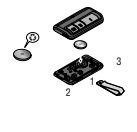
NOTICE: This device complies with Part 15 of the FCC rules and Industry Canada’s license-exempt RSSs. Operation is subject to the following two conditions: (1) this device may not cause harmful interference, and (2) this device must accept any interference received, including interference that may cause undesired operation.
Any changes or modifications not expressly approved by the party responsible for compliance could void the user’s authority to operate the equipment.
This device must be installed to ensure a minimum 20 cm (8 in.) distance is maintained between users/bystanders and device.
This device has been tested and found to comply with the limits for a Class B digital device, pursuant to part 15 of the FCC rules and Industry Canada ICES standard. These limits are designed to provide reasonable protection against harmful interference in a residential installation. This equipment generates, uses and can radiate radio frequency energy and, if not installed and used in accordance with the instructions, may cause harmful interference to radio communications. However, there is no guarantee that interference will not occur in a particular installation.
If this equipment does cause harmful interference to radio or television reception, which can be determined by turning the equipment off and on, the user is encouraged to try to correct the interference by one or more of the following measures:
– Reorient or relocate the receiving antenna.
– Increase the separation between the equipment and receiver.
– Connect the equipment into an outlet on a circuit different from that to which the receiver is connected.
– Consult the dealer or an experienced radio/TV technician for help.
Troubleshooting
Diagnostic Chart
Your garage door opener is programmed with self-diagnostic capabilities. The UP and DOWN arrows on the garage door opener flash the diagnostic codes.
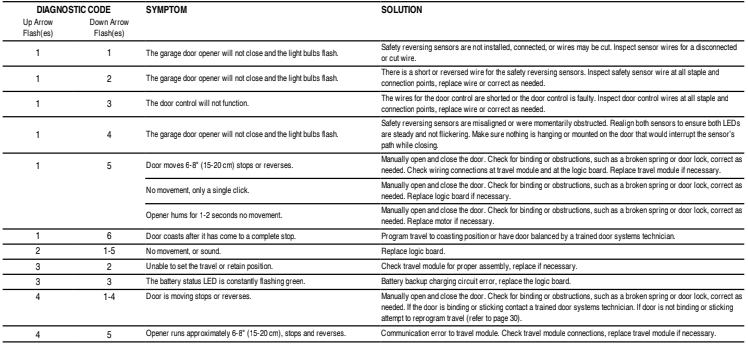

The garage door opener can beep for several reasons:
– Operating on battery power or the 12 Vdc battery needs to be replaced, see page 32.
– Garage door opener has been activated through a device or feature such as Timer-to-Close or garage door monitor, see page 37.
My remote control will not activate the garage door:
– Verify the lock feature is not activated on the door control.
– Reprogram the remote control.
– If the remote control will still not activate the door check the diagnostic codes to ensure the garage door opener is working properly.
My door will not close and the light bulbs blink on my motor unit:
The safety reversing sensor must be connected and aligned correctly before the garage door opener will move in the down direction.
– Verify the safety reversing sensors are properly installed, aligned and free of any obstructions.
My garage door opener light(s) will not turn off when the door is open:
The garage door opener is equipped with a feature that turns the light on when the safety reversing sensors have been obstructed or when the motion sensor on the door control detects movement in the garage. These features can be disabled using the door control, see page 36. Wi-Fi troubleshooting
The garage door opener will NOT enter Wi-Fi LEARN mode:
– After the initial installation of the garage door opener, the garage door opener must complete a full cycle (open and closed) before the Wi-Fi LEARN mode can be activated.
– If there has been a recent power outage, the garage door opener must complete a full cycle before the Wi-Fi LEARN mode can be activated.
See page 33 to activate Wi-Fi LEARN mode.
If your black adjustment button is not solid green go to wifihelp.chamberlain.com.
My vehicle’s Homelink® is not programming to my garage door opener:
Compatibility BridgeTM (not included) may be necessary for certain vehicles. Visit bridge.chamberlain.com to find out if a Bridge is needed.
My neighbor’s remote control opens my garage door:
Erase the memory from your garage door opener and reprogram the remote control(s).
Green battery status LED – All systems are normal:
– A solid green LED light indicates the battery is fully charged.
– A flashing green LED indicates the battery is being charged.
Orange battery status LED – The garage door opener has lost power and is in battery backup mode:
– A solid orange LED with beep, sounding approximately every 2 seconds, indicates the garage door opener is operating on battery power.
– A flashing orange LED with beep, sounding every 30 seconds, indicates the battery is low.
Red battery status LED – The garage door opener’s 12V battery needs to be replaced:
– A solid red LED with beep, sounding every 30 seconds, indicates the 12V battery will no longer hold a charge and needs to be replaced. Please call for replacement battery to allow your system to operate during a power outage.

Accessories

MyQ® Accessories
You can program up to 10 MyQ® accessories to your MyQ® account.

Warranty
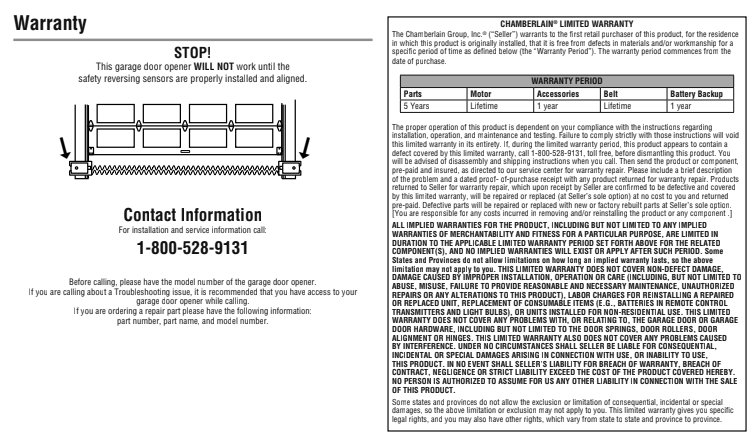
Automatic Garage Door Opener Safety & Maintenance Guide
Garage Door Opener Safety – An Automatic Decision
A garage door is the largest moving object in the home. An improperly adjusted garage door and opener can exert deadly force when the door closes – which could lead to entrapment of children or adults and subsequent injury or death.
Proper installation, operation, maintenance, and testing of the garage door and automatic opener are necessary to provide a safe, trouble-free system. Careless operation or allowing children to play with or use garage door opener controls are also dangerous situations that can lead to tragic results. A few simple precautions can protect your family and friends from potential harm. Please review the safety and maintenance tips in this guide carefully and keep it for reference. Check the operation of your garage door and opener to ensure they function in a safe and trouble-free manner. Be sure to read all Important Safety Information found in your garage door opener’s manual as it provides more details and safety considerations than can be supplied with this guide.
Garage Door Openers are Not Toys
Discuss garage door and opener safety with your children. Explain the danger of being trapped under the door.
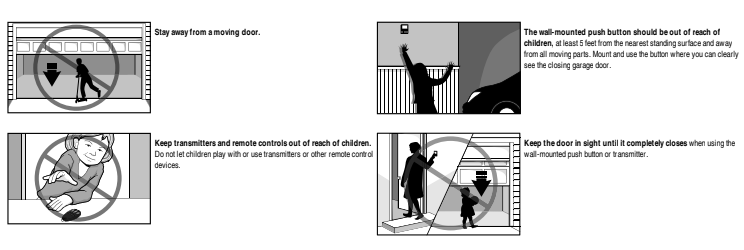
Routine Maintenance Can Prevent Tragedies
Make monthly inspection and testing of your garage door and opener system a part of your regular routine. Review your owner’s manual for both the door and door opener. If you don’t have the owner’s manuals, contact the manufacturer(s) and request a copy for your specific model(s). Look for the opener model number on the back of the power unit.
WARNING – Springs are under high tension. Only qualified individuals should adjust them.

Visually check the door and installation:
– Starting with the door in the closed position, use the manual disconnect on the opener to disconnect the door.
– Look for signs of wear or damage on hinges, rollers, springs, and door panels.
– These parts may require periodic lubrication. Check the owner’s manual for suggested maintenance.
– If any signs of damage are evident, contact a trained door systems technician for assistance.
– Verify the photoeye height is no higher than 6″ from the garage floor.
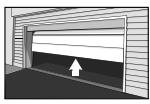
Test the door for proper operation:
– Open and close the door manually using handles or suitable gripping points.
– The door should move freely and without difficulty.
– The door should balance and stay partially open 3–4 feet above the floor.
– If you detect any signs of improper operation, contact a trained door systems technician for assistance.
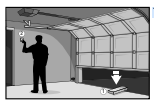
Test the opener safety features:
– Reconnect the opener to the door using the manual disconnect and open the door.
– Place a 2×4 board flat in the path of the door (1) and try to close it (2). The door should stop when it comes in contact with the 2×4 and then reverse direction.
– Block the photoelectric sensor by waving an object in front of the sensor and attempt to close the door. The door should not close unless the wall-mounted push button is manually held during operation.
– If the opener does not perform as described, contact a trained door systems technician for assistance.
Repair Parts
Rail Assembly Parts
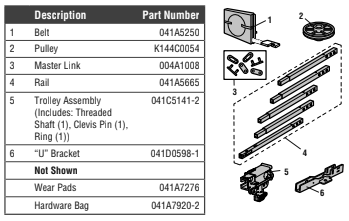
Accessories
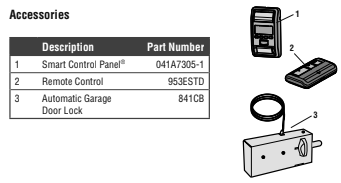
Installation Parts
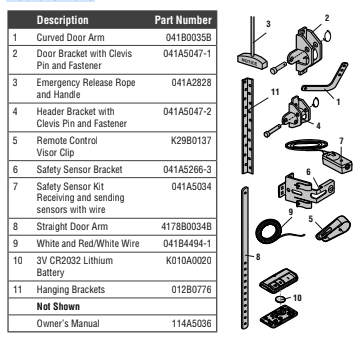
Garage Door Opener Parts
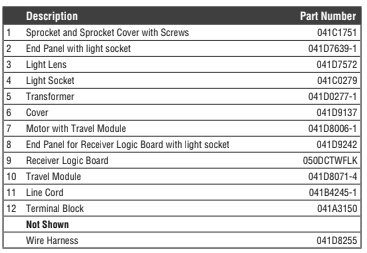
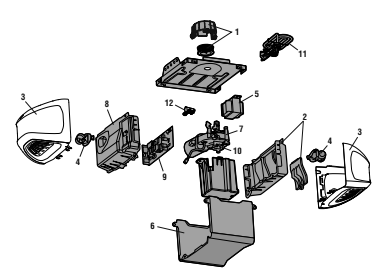
you can download the PDF version of the Chamberlain Smart Garage Opener Owner’s Manual (B980 Belt Drive Garage Door Opener) here.
